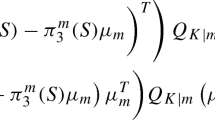Abstract
A reparameterization of a latent class model is presented to simultaneously classify and scale nominal and ordered categorical choice data. Latent class-specific probabilities are constrained to be equal to the preference probabilities from a probabilistic ideal-point or vector model that yields a graphical, multidimensional representation of the classification results. In addition, background variables can be incorporated as an aid to interpreting the latent class-specific response probabilities. The analyses of synthetic and real data sets illustrate the proposed method.
Similar content being viewed by others
References
Aitkin, M., Anderson, D., & Hinde, J. (1981). Statistical modeling of data on teaching styles.Journal of the Royal Statistical Society, Series A, 144, 419–461.
Anderson, J. A. (1984). regression and ordered categorical variables.Journal of the Royal Statistical Society, Series B, 46, 1–30.
Akaike, H. (1974). A new look at statistical model identification.IEEE Transactions on Automatic Control, Ac-19, 716–723.
Bartholomew, D. J. (1987).Latent variable models and factor analysis. New York: Oxford University Press.
Bock, R. D., & Aitkin, M. (1981). Marginal maximum likelihood estimation of item parameters: Application of an EM algorithm.Psychometrika, 46, 443–459.
Böckenholt, I., & Gaul, W. (1986). Analysis of choice behavior via probabilistic ideal point and vector models.Applied Stochastic Models and Data Analysis, 2, 202–226.
Böckenholt, U. (1990). Multivariate Thurstonian models.Psychometrika, 55, 391–404.
Carroll, J. D. (1980). Models and methods for multidimensional analysis of preferential choice data. In Lanterman, E. D. & Feger, H. (Eds.),Similarity and choice (pp. 234–289). Bern: Huber.
Clogg, C. C., & Goodman, L. A. (1984). Latent structure analysis of a set of multidimensional contingency tables.Journal of the American Statistical Association, 77, 803–815.
Coombs, C. H. (1964).A theory of data. New York: Wiley.
Dayton, C. M., & Macready, G. B. (1988). A latent class covariate model with applications to criterion-referenced testing. In R. Langeheine & J. Rost (Eds.),Latent trait and latent class models (pp. 129–146). New York: Plenum.
DeSarbo, W. S., & Cho, J. (1989). A stochastic multidimensional scaling vector threshold model for the spatial representation of “pick any/n” data.Psychometrika, 54, 105–130.
DeSarbo, W. S., & Hoffman, D. L. (1986). A new unfolding threshold model for the spatial representation of binary choice data.Applied Psychological Measurement, 10, 247–264.
DeSarbo, W. S., Howard, D. J., & Jedidi, K. (1991). MULTICLUS: A new methodology for simultaneously performing multidimensional scaling and cluster analysis.Psychometrika, 56, 121–136.
DeSarbo, W. S., Jedidi, K., Cool, K., Schendel, D. (1989).Strategic groups, conduct and goal asymmetry: The STATGROUP methodology. Unpublished manuscript, University of Michigan.
DeSoete, G., & Carroll, J. D. (1983). A maximum likelihood method for fitting the wandering vector model.Psychometrika, 48, 553–566.
DeSoete, G., Carroll, J. D., & DeSarbo, W. S. (1986). The wandering ideal-point model: A probabilistic multidimensional unfolding model for paired comparison data.Journal of Mathematical Psychology, 30, 28–41.
Formann, A. K. (1984).Die Latent-Class-Analyse: Einführung in Theorie und Anwendung [Latent class analysis: An introduction to theory and applications]. Weinheim: Beltz Verlag.
Formann, A. K. (1985). Constrained latent class models: Theory and applications.British Journal of Mathematical and Statistical Psychology, 38, 87–111.
Goodman, L. A. (1978).Analyzing qualitative/categorical data: Log-linear models and latent-structure analysis. Cambridge: Abt Books.
Goodman, L. A. (1979). On the estimation of parameters in latent structure analysis.Psychometrika, 44, 123–128.
Holbrook, M. B., Moore, W. L., & Winer, R. S. (1982). Constructing joint spaces from pick-any data: A new tool for consumer analysis.Journal of Consumer Research, 9, 99–105.
Hoijtink, H. (1990). A latent trait model for dichotomous choice data.Psychometrika, 55, 641–656.
Langeheine, R., & Rost, J. (1988).Latent trait and latent class models. New York: Plenum.
Lazarsfeld, P. F. (1950). Logical and mathematical foundations of latent structure analysis. In S. A. Stouffer et al. (Eds.),Studies in social psychology in World War II, Vol. IV (pp. 362–412). Princeton: Princeton University Press.
McCullagh, P. (1980). Regression models for ordinal data.Journal of the Royal Statistical Society, Series B, 42, 109–142.
Mislevy, R. J., & Verhelst, N. (1990). Modeling item responses when different subjects employ different solution strategies.Psychometrika, 55, 195–216.
Rindskopf, D. (1983). A general framework for using latent class analysis to test hierarchical and nonhierarchical learning models.Psychometrika, 48, 85–97.
Rost, J. (1985). A latent class model for rating data.Psychometrika, 50, 37–49.
Rost, J. (1988a). Rating scale analysis with latent class models.Psychometrika, 53, 327–348.
Rost, J. (1988b).Quantitative and qualitative probabilistische Testtheorie [Quantitative and qualitative probabilistic test theory]. Bern: Huber.
Schönemann, P. H., & Tucker, L. R. (1967). A maximum likelihood solution for the method of successive intervals allowing for unequal stimulus dispersions.Psychometrika, 32, 403–417.
Takane, Y. (1981). Multidimensional successive categories scaling: A maximum likelihood method.Psychometrika, 46, 9–28.
Takane, Y. (1983).Choice model analysis of the “pick any/n” type of binary data. Handout at the European Psychometric and Classification Meetings, Jouy-en-Josas, France.
Takane, Y., & deLeeuw, J. (1987). On the relationship between item response theory and factor analysis of discretized variables.Psychometrika, 52, 393–408.
Tucker, L. R. (1960). Intra-individual and inter-individual multidimensionality. In H. Gulliksen & S. Messick (Eds.),Psychological scaling: Theory and applications. (pp. 155–167). New York: Wiley.
Author information
Authors and Affiliations
Additional information
The authors thank Yosiho Takane, the editor and referees for their valuable suggestions. Authors are listed in reverse alphabetical order.
Rights and permissions
About this article
Cite this article
Böckenholt, U., Böckenholt, I. Constrained latent class analysis: Simultaneous classification and scaling of discrete choice data. Psychometrika 56, 699–716 (1991). https://doi.org/10.1007/BF02294500
Received:
Revised:
Issue Date:
DOI: https://doi.org/10.1007/BF02294500




